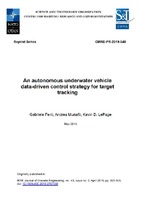| dc.contributor.author | Ferri, Gabriele | |
| dc.contributor.author | Munafò, Andrea | |
| dc.contributor.author | LePage, Kevin D. | |
| dc.date.accessioned | 2019-06-18T14:29:48Z | |
| dc.date.available | 2019-06-18T14:29:48Z | |
| dc.date.issued | 2019/05 | |
| dc.identifier.govdoc | CMRE-PR-2019-049 | en_US |
| dc.identifier.uri | http://hdl.handle.net/20.500.12489/789 | |
| dc.description.abstract | This paper presents a data-driven approach to control the movement of autonomous underwater vehicles (AUVs) operating as receivers of a multistatic sonar surveillance network. The algorithm adopts a nonmyopic receding horizon policy to control the AUV heading, with the objective of minimizing the expected estimate error in the target location produced by the onboard tracker. Minimizing this error is of the utmost interest in target state estimation since it is one way of maintaining tracks. The proposed policy builds on an automated perception module which produces a target track and on an acoustic model to estimate the target measurement signal-to-noise ratio. Driven by the mission objectives, it explores the best decisions for the AUV by evaluating the evolution of the tactical situation over a future time window. Nonmyopic approaches can offer increased performance if compared to myopic ones. The downside is an increase of the computational burden. Methods are described to simplify and solve effectively the resulting decision tree to allow the execution of these kinds of computational intensive algorithms onboard autonomous vehicles. At the same time, they aim at producing AUV paths robust to possible misleading target measurements, which might cause meandering trajectories. These are crucial factors to use datadriven strategies for AUVs which must work in real applications. Results from the COLLAB13 sea trial are reported and discussed. They show both the feasibility of executing the algorithm in realtime on an onboard computer and the benefits of using the proposed approach over conventional predefined paths. These results are, to the best of our knowledge, the first successful demonstration at sea of a complex nonmyopic algorithm running in realtime onboard AUVs in a realistic multistatic littoral surveillance scenario. | en_US |
| dc.format | 21 p. : ill. ; digital, PDF file | en_US |
| dc.language.iso | en | en_US |
| dc.publisher | CMRE | en_US |
| dc.source | In: IEEE Journal of Oceanic Engineering, vol. 43, issue no. 2, April 2018, pp. 323-343, doi: 10.1109/JOE.2018.2797558 | en_US |
| dc.subject | Autonomous Underwater Vehicles (AUV) | en_US |
| dc.subject | Anti-Submarine Warfare (ASW) | en_US |
| dc.subject | Target tracking | en_US |
| dc.subject | Underwater surveillance | en_US |
| dc.subject | Control engineering | en_US |
| dc.subject | Control theory | en_US |
| dc.subject | Multistatic sonar | en_US |
| dc.subject | Cooperative systems | en_US |
| dc.subject | COLLAB 13 trial | en_US |
| dc.subject | Mathematical optimization - Data processing | en_US |
| dc.subject | Algorithms | en_US |
| dc.title | An autonomous underwater vehicle data-driven control strategy for target tracking | en_US |
| dc.type | Reprint (PR) | en_US |
| dc.type | Papers and Articles | en_US |
